
St. Augustine is a city in and the county seat of St. Johns County located 40 miles south of downtown Jacksonville. The city is on the Atlantic coast of northeastern Florida. Founded in 1565 by Spanish explorers, it is the oldest continuously inhabited European-established settlement in what is now the contiguous United States.

Flagler College is a private liberal arts college in St. Augustine, Florida. It was founded in 1968 and offers 33 undergraduate majors and one master's program. It also has a campus in Tallahassee.
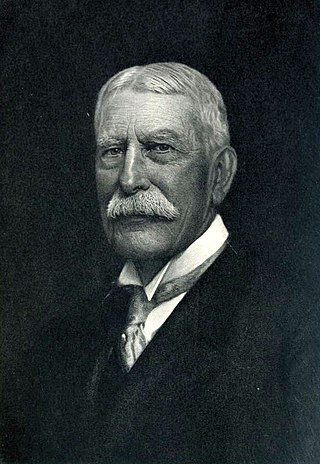
Henry Morrison Flagler was an American industrialist and a founder of Standard Oil, which was first based in Ohio. He was also a key figure in the development of the Atlantic coast of Florida and founder of the Florida East Coast Railway. He is also known as a founder of the cities of Miami and Palm Beach, Florida.

Carrère and Hastings, the firm of John Merven Carrère and Thomas Hastings, was one of the outstanding American Beaux-Arts architecture firms. Located in New York City, the firm practiced from 1885 until 1929, although Carrère died in an automobile accident in 1911.

The Lightner Museum is a museum of antiques, mostly American Gilded Age pieces, housed within the historic Hotel Alcazar building in downtown St. Augustine. This 1887 Spanish Renaissance Revival style building is listed on the National Register of Historic Places.

Thomas Hastings was an American architect, a partner in the firm of Carrère and Hastings.

Whitehall is a 75-room, 100,000 square foot Gilded Age mansion open to the public in Palm Beach, Florida in the United States. Completed in 1902, it is a major example of neoclassical Beaux Arts architecture designed by Carrère and Hastings for Henry Flagler, a leading captain of industry in the late 19th century, and a leading developer of Florida as a tourist destination. The building is listed a National Historic Landmark. It now houses the Henry Morrison Flagler Museum, named after its builder.

The Casa Monica Hotel is a historic hotel located in St. Augustine, Florida, in the United States. It was originally named Casa Monica, then Cordova Hotel, then Alcazar Annex, and now has its original name again. The Casa Monica Hotel is one of the oldest hotels in the United States and is a member of the Historic Hotels of America in the National Trust for Historic Preservation.
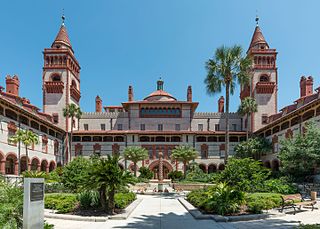
The Hotel Ponce de Leon, also known as The Ponce, was a luxury hotel in St. Augustine, Florida, built by millionaire developer and Standard Oil co-founder Henry M. Flagler. Built between 1885-1887, the winter resort opened in January 1888. The hotel was designed in the Spanish Renaissance Revival style as the first major project of the New York architecture firm Carrère & Hastings, which gained world renown for more than 600 projects, including the House and Senate Office Buildings flanking the US Capitol. Their final project was the New York Public Library.

Lincolnville Historic District is a neighborhood in St. Augustine, Florida established by freedmen following the American Civil War and located on the southwest peninsula of the "nation's oldest city." It was designated as an historic district in 1991 and listed on the National Register of Historic Places. Originally recorded with 548 contributing buildings, the district is bounded by Cedar, Riberia, Cerro and Washington streets and DeSoto Place.
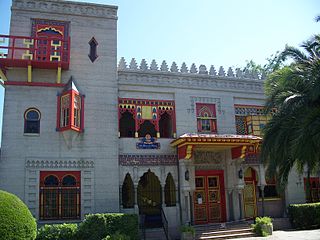
Villa Zorayda is a house at 83 King Street in St. Augustine, Florida. Built in 1883 by the eccentric Boston millionaire Franklin W. Smith as his winter home, it was inspired by the 12th-century Moorish Alhambra Palace in Granada, Spain. Smith named it "Villa Zorayda", after one of the princesses in Washington Irving's Tales of the Alhambra. The building and part of Franklin Smith's art and antique collection were sold to Abraham Mussallem, a rug and antiquities merchant originally from Syria, in 1913. On September 23, 1993, it was added to the U.S. National Register of Historic Places. The Villa Zorayda Museum is still owned by the Mussallem family and contains the original art and antique collection assembled by Franklin Smith and Abraham Mussallem.

The St Augustine Town Plan Historic District is a U.S. National Historic Landmark District encompassing the colonial heart of the city. It substantially encompasses the street plan of the city as contained within the bounds of walls built between the 16th and early 19th centuries. The district is bounded by Cordova, Orange, and St. Francis Streets, and Matanzas Bay. It was designated a National Historic Landmark in 1970, although its boundaries were not formally defined until 1986.

The Old Jail is a historic jail in St. Augustine, Florida. It is located at 167 San Marco Avenue. On August 27, 1987, it was added to the U.S. National Register of Historic Places. The St. Johns County Jail now serves as the Old Jail Museum.

Markland, also known as the Andrew Anderson House, is a historic mansion in St. Augustine, Florida. It was built in the Greek Revival style of Classical Revival architecture.
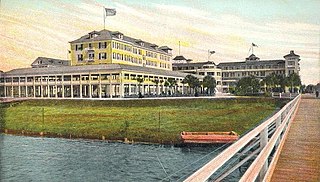
The Ormond Hotel was a historic hotel in Ormond Beach, Florida, United States. It was located at 15 East Granada Boulevard.

Emmanuel Louis Masqueray (1861–1917) was a Franco-American preeminent figure in the history of American architecture, both as a gifted designer of landmark buildings and as an influential teacher of the profession of architecture dedicated to the principles of Beaux-Arts architecture.

The Memorial Presbyterian Church is a historic church constructed in St. Augustine, Florida, in 1889 by American industrialist Henry Morrison Flagler. It is located at 32 Sevilla Street. It was dedicated to the memory of his daughter Jennie Louise Benedict, who died following complications from childbirth at sea in March 1889.
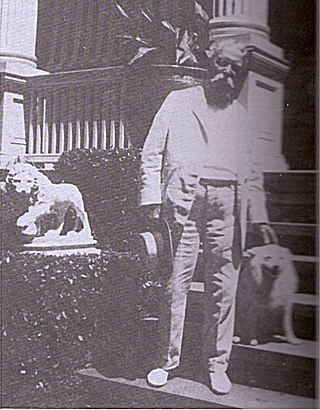
Andrew Anderson II was an American physician, philanthropist, mayor and benefactor of St. Augustine, Florida. Anderson commissioned multiple works of art to adorn a variety of public spaces in the city of St. Augustine, including the two Medici lion statues placed at the approach to the Bridge of Lions.
St. Augustine, Florida, the oldest continuously occupied settlement of European origin in the continental United States, was founded in 1565 by Spanish admiral Pedro Menéndez de Avilés. The Spanish Crown issued an asiento to Menéndez, signed by King Philip II on March 20, 1565, granting him various titles, including that of adelantado of Florida, and expansive privileges to exploit the lands in the vast territory of Spanish Florida, called La Florida by the Spaniards. This contract directed Menéndez to explore the region's Atlantic coast and report on its features, with the object of finding a suitable location to establish a permanent colony from which the Spanish treasure fleet could be defended and Spain's claimed territories in North America protected against incursions by other European powers.
Lawrence Lewis Jr. (1918-1995) was an American businessman, hotelier, philanthropist, and benefactor remembered for his role in founding Flagler College.


















